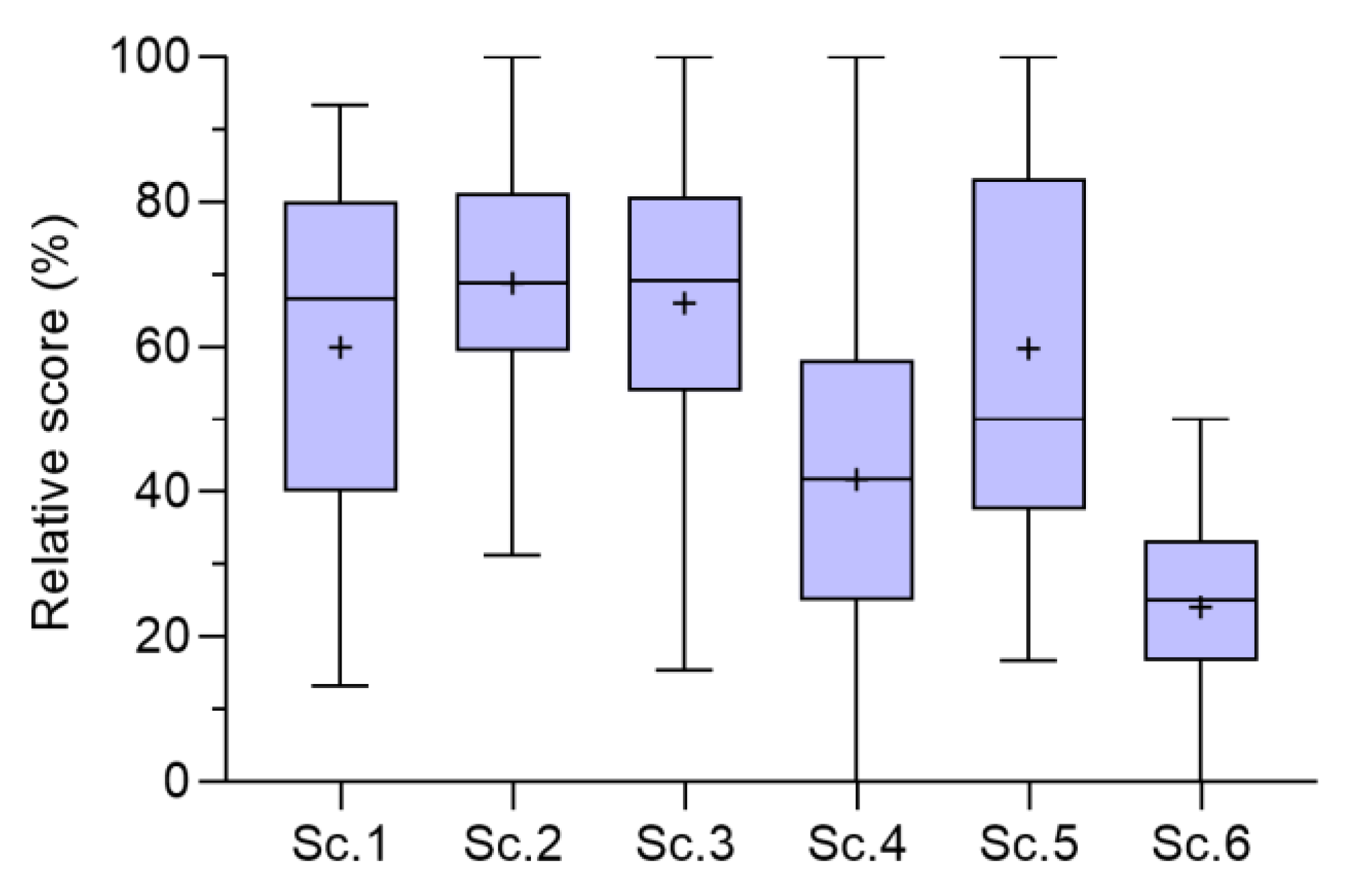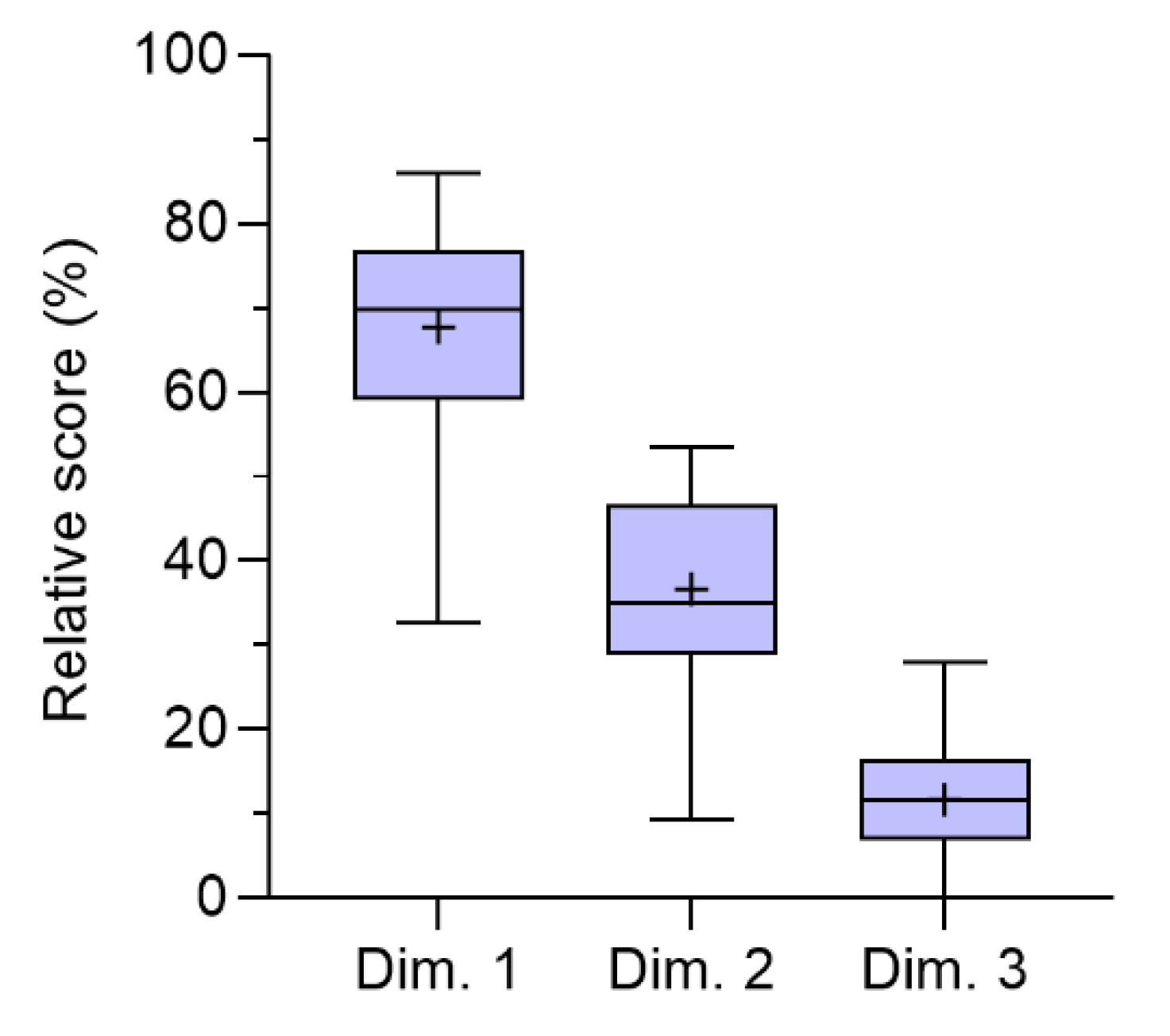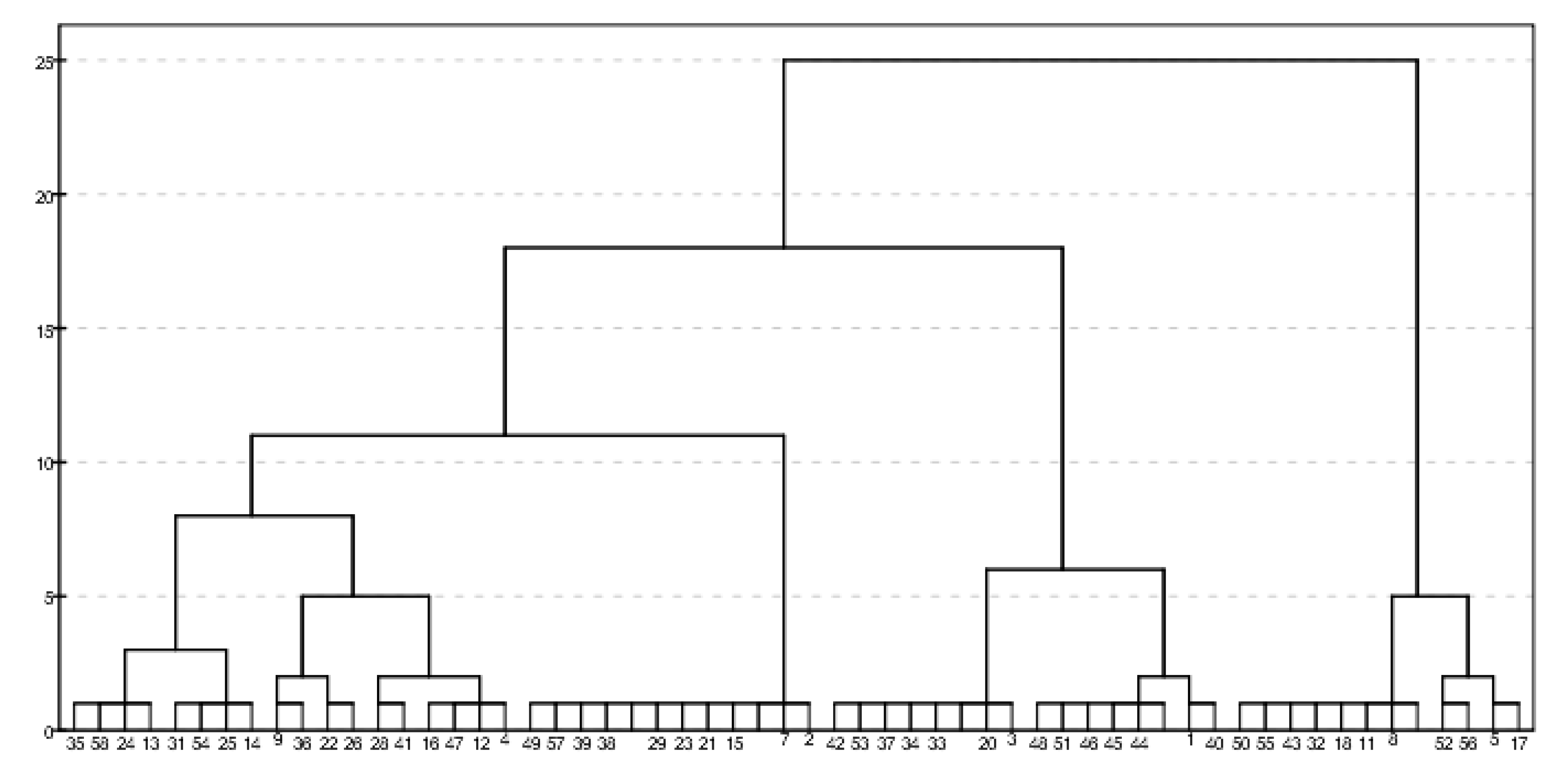Analysis of Learning Motivation in Industrial Engineering Teaching in University of Extremadura (Spain)
Abstract
:1. Introduction
2. Methodology
3. Results
3.1. Internal Consistency of the Instrument
3.2. Scores
3.3. Percentiles
3.4. Correlations among Scales and among Dimensions
3.5. Students’ Motivation
4. Discussion
5. Conclusions
Author Contributions
Funding
Acknowledgments
Conflicts of Interest
References
- Palmero, F. Motivación: Conducta y proceso. Rev. Electrón. Motiv. Emoc. 2005, 8, 1–29. [Google Scholar]
- Zamora-Polo, F.; Martínez Sánchez-Cortés, M.; Reyes-Rodríguez, A.M.; García-Sanz-Calcedo, J. Developing Project Managers’ Transversal Competences Using Building Information Modeling. Appl. Sci. 2019, 9, 4006. [Google Scholar] [CrossRef] [Green Version]
- Carrillo, M.; Padilla, J.; Rosero, T.; Villagómez, M.S. La motivación y el aprendizaje. ALTERIDAD Rev. Educ. 2009, 4, 20–32. [Google Scholar] [CrossRef] [Green Version]
- Beamud González, E.M.; Núñez López, P.J.; García Plaza, E.; Rodríguez Salgado, D.; González González, A.; Garcia-Sanz-Calcedo, J.G. Reverse Engineering Applied to the Teaching of Computer Aided Manufacturing. Mater. Sci. Forum 2017, 903, 120–127. [Google Scholar] [CrossRef]
- Joseph, R.D.B.; Pal, A.; Tunks, J.; Mehta, G. Intrinsic vs. Extrinsic Motivation in an Interactive Engineering Game. J. Adv. Comput. Eng. Technol. 2019, 5, 37–48. [Google Scholar]
- Romero-García, O. Motivando Para el Trabajo; Cuadernos Lagoven, Serie Siglo XXI: Caracas, Venezuela, 1985. [Google Scholar]
- Singh, K. Study of Achievement Motivation in Relation to Academic Achievement of Students. Int. J. Educ. Plan. Adm. 2011, 1, 161–171. [Google Scholar]
- Fırat, M.; Kılınç, H.; Yüzer, T.V. Level of intrinsic motivation of distance education students in e-learning environments. J. Comput. Assist. Learn. 2018, 34, 63–70. [Google Scholar] [CrossRef]
- Wang, X. Why Students Choose STEM Majors. Am. Educ. Res. J. 2013, 50, 1081–1121. [Google Scholar] [CrossRef]
- Dowker, A.; Sarkar, A.; Looi, C.Y. Mathematics Anxiety: What Have We Learned in 60 Years? Front. Psychol. 2016, 7. [Google Scholar] [CrossRef] [Green Version]
- Castro, E.J.; Miranda, I. Experiencias Desmotivacionales y Motivacionales de Estudiantes Varones de Ingeniería para Estudiar Matemáticas. El Caso de la Universidad Andrés Bello en Santiago de Chile. Form. Univ. 2019, 12, 83–92. [Google Scholar] [CrossRef] [Green Version]
- Corrales-Serrano, M.; Sánchez-Martín, J.; Moreno-Losada, J.; Zamora-Polo, F. Motivations of young people for the study: Roots and consequences. Cuad. Investig. Juv. 2018, 4, e020. [Google Scholar]
- Corrales-Serrano, M. Estudio de las Motivaciones Internas y Externas para la Elección de Modalidad del Alumnado de Bachillerato. Incidencia en la Didáctica de las Ciencias Sociales; University of Extremadura: Extremadura, Spain, 2020. [Google Scholar]
- Moreno-Losada, J. Estudio “con-Sentido” en la Universidad. Motivación del Estudio en los Universitarios Extremeños y el Bien Interno de las Profesiones; University of Extremadura: Extremadura, Spain, 2015. [Google Scholar]
- Pérez-Foguet, A.; Lazzarini, B.; Giné, R.; Velo, E.; Boni, A.; Sierra, M.; Zolezzi, G.; Trimingham, R. Promoting sustainable human development in engineering: Assessment of online courses within continuing professional development strategies. J. Clean. Prod. 2018, 172, 4286–4302. [Google Scholar] [CrossRef] [Green Version]
- Lazzarini, B.; Pérez-Foguet, A.; Boni, A. Key characteristics of academics promoting Sustainable Human Development within engineering studies. J. Clean. Prod. 2018, 188, 237–252. [Google Scholar] [CrossRef] [Green Version]
- General Assembly of United Nations Transforming our world: The 2030 Agenda for Sustainable Development. Resolution adopted by the General Assembly on 25 September 2015. Available online: http://www.un.org/ga/search/view_doc.asp?symbol=A/RES/70/1&Lang=E (accessed on 7 November 2018).
- Boni, A.; Lopez-Fogues, A.; Walker, M. Higher education and the post-2015 agenda: A contribution from the human development approach. J. Glob. Ethics 2016, 12, 17–28. [Google Scholar] [CrossRef]
- Lazzarini, B.; Pérez-Foguet, A. Profiling research of the engineering academics who successfully promote education in Sustainable Human Development. J. Clean. Prod. 2018, 172, 4239–4253. [Google Scholar] [CrossRef] [Green Version]
- Zamora-Polo, F.; Sánchez-Martín, J.; Corrales-Serrano, M.; Espejo-Antúnez, L. What Do University Students Know about Sustainable Development Goals? A Realistic Approach to the Reception of this UN Program Amongst the Youth Population. Sustainability 2019, 11, 3533. [Google Scholar] [CrossRef] [Green Version]
- Zamora-Polo, F.; Sánchez-Martín, J. Teaching for a Better World. Sustainability and Sustainable Development Goals in the Construction of a Change-Maker University. Sustainability 2019, 11, 4224. [Google Scholar] [CrossRef] [Green Version]
- Sánchez-Martín, J.; Cañada-Cañada, F.; Dávila-Acedo, M.A. Just a game? Gamifying a general science class at university: Collaborative and competitive work implications. Think. Ski. Creat. 2017, 26, 51–59. [Google Scholar] [CrossRef]
- Buckley, P.; Doyle, E. Gamification and student motivation. Interact. Learn. Environ. 2016, 24, 1162–1175. [Google Scholar] [CrossRef]
- Terrón-López, M.-J.; García-García, M.-J.; Velasco-Quintana, P.-J.; Ocampo, J.; Vigil Montaño, M.-R.; Gaya-López, M.-C. Implementation of a project-based engineering school: Increasing student motivation and relevant learning. Eur. J. Eng. Educ. 2017, 42, 618–631. [Google Scholar] [CrossRef]
- Jeong, J.; Cañada-Cañada, F.; González-Gómez, D. The Study of Flipped-Classroom for Pre-Service Science Teachers. Educ. Sci. 2018, 8, 163. [Google Scholar] [CrossRef] [Green Version]
- Jeong, J.S.; González-Gómez, D.; Cañada-Cañada, F.; Gallego-Picó, A.; Bravo, J.C. Effects of active learning methodologies on the students’ emotions, self-efficacy beliefs and learning outcomes in a science distance learning course. J. Technol. Sci. Educ. 2019, 9, 217. [Google Scholar] [CrossRef]
- Lassen, A.K.; Hjelseth, E.; Tollnes, T. Enhancing learning outcomes by introducing BIM in civil engineering studies—Experiences from a university college in Norway. Int. J. Sustain. Dev. Plan. 2018, 13, 62–72. [Google Scholar] [CrossRef] [Green Version]
- Maquilón Sánchez, J.J.; Hernández Pina, F. Influencia de la motivación en el rendimiento académico de los estudiantes de formación profesional. REIFOP 2011, 14, 81–100. [Google Scholar]
- Montero, I.; Alonso Tapia, J. El cuestionario MAPE-II. In Motivar en la Adolescencia: Teoría, Evaluación e Intervención; Servicio de Publicaciones de la Universidad Autónoma de Madrid: Madrid, Spain, 1992; pp. 205–231. ISBN 84-7477-414-4. [Google Scholar]
- IBM Corp. IBM Statistics, 25th ed.; IBM Corp. Released: New York, NY, USA, 2019. [Google Scholar]
- Kuder, G.F.; Richardson, M.W. The theory of the estimation of test reliability. Psychometrika 1937, 2, 151–160. [Google Scholar] [CrossRef]
- Pearson, K. VII. Note on regression and inheritance in the case of two parents. Proc. R. Soc. Lond. 1895, 58, 240–242. [Google Scholar]
- Ward, J.H. Hierarchical Grouping to Optimize an Objective Function. J. Am. Stat. Assoc. 1963, 58, 236. [Google Scholar] [CrossRef]
- Alonso Tapia, J. Evaluación de la motivación en entornos educativos. In Manual de Orientación y Tutoría; Álvarez, M., Bisquerra, R., Eds.; Kluwer: Barcelona, Spain, 2007; pp. 1–39. ISBN 84-7197-380-4. [Google Scholar]
- Nicholls, J.G. Conceptions of ability and achievement motivation: A theory and its implications for education. In Learning and Motivation in the Classroom; Paris, S.G., Olson, G.M., Stevenson, H.W., Eds.; Routledge: London, UK, 2018; pp. 211–238. ISBN 9781315188522. [Google Scholar]
- García Sanz-Calcedo, J.G.; Salgado, D.R.; Cambero, I.; Herrera, J.M. Application of Techniques Based on Reliability for the Improvement of the Teaching of Mechanisms in Industrial Design. In New Trends in Educational Activity in the Field of Mechanism and Machine Theory. Mechanisms and Machine Science; Springer: Cham, Switzerland, 2014; pp. 101–107. [Google Scholar]
- Alonso Tapia, J. Motivaciones, expectativas y valores relacionados con el aprendizaje. Análisis empírico e implicaciones para la mejora de la actuación docente en la enseñanza secundaria y en el bachillerato. In Premios Nacionales de Investigación Educativa 2003; Ministerio de Educación y Deporte: Madrid, Spain, 2005; pp. 255–314. ISBN 84-369-3941-7. [Google Scholar]
- Robinson, K.A.; Lee, Y.; Bovee, E.A.; Perez, T.; Walton, S.P.; Briedis, D.; Linnenbrink-Garcia, L. Motivation in transition: Development and roles of expectancy, task values, and costs in early college engineering. J. Educ. Psychol. 2019, 111, 1081–1102. [Google Scholar] [CrossRef]
- González, A.G.; Salgado, D.R.; García Sanz-Calcedo, J.G.; García, C.C.; Muriel, J.B.; Pérez, O.L.; García, F.J.Á. A teaching methodology for the real-time assessment of students’ competencies related to manufacturing subjects using technology based on electronic devices. Procedia Manuf. 2019, 41, 579–586. [Google Scholar] [CrossRef]
- Ruiz, J. Experiencias de motivación a los alumnos de enseñanza universitaria técnica y artística. In Proceedings of the Actas del XVI Congreso Universitario de Innovación Educativa en las Enseñanzas Técnicas, Cádiz, Spain, 23–26 September 2008. [Google Scholar]
- Cifuentes Pérez, P.; Meseguer Cutillas, P. Trabajo en equipo frente a trabajo individual. Tonos Digit. Rev. Estud. Filos. 2015, 28, 17–20. [Google Scholar]
- Madni, A.M.; Sievers, M. Model-based systems engineering: Motivation, current status, and research opportunities. Syst. Eng. 2018, 21, 172–190. [Google Scholar] [CrossRef]
- Park, S.; Kaplan, H.; Schlaf, R. Interdisciplinary flipped learning for engineering classrooms in higher education: Students’ motivational regulation and design achievement. Comput. Appl. Eng. Educ. 2018, 26, 589–601. [Google Scholar] [CrossRef]
- González-Domínguez, J.; Sánchez-Barroso, G.; Zamora-Polo, F.; García-Sanz-Calcedo, J. Application of circular economy techniques for design and development of products through collaborative project-based learning for industrial engineer teaching. Sustainability 2020, 12, 4368. [Google Scholar] [CrossRef]



| Dimensions | Levels | |||||
|---|---|---|---|---|---|---|
| High | Medium | Low | ||||
| N | % | N | % | N | % | |
| Motivation to learn | 42 | 72.4% | 14 | 24.1% | 2 | 3.5% |
| Motivation to results | 30 | 51.7% | 26 | 44.8% | 2 | 3.5% |
| Fear to failure | 12 | 20.7% | 28 | 48.3% | 18 | 31.0% |
| Dimensions | Levels | |||||
|---|---|---|---|---|---|---|
| High | Medium | Low | ||||
| N | % | N | % | N | % | |
| High capacity for work and performance | 38 | 64.4% | 20 | 34.5% | 0 | 0.0% |
| Intrinsic motivation | 20 | 34.5% | 32 | 55.2% | 6 | 10.3% |
| Ambition | 22 | 37.9% | 34 | 58.5% | 2 | 3.5% |
| Anxiety inhibiting performance | 12 | 20.7% | 28 | 48.3% | 18 | 31.0% |
| Anxiety enabling performance | 26 | 44.8% | 24 | 42.4% | 8 | 13.8% |
| Laziness | 4 | 6.9% | 46 | 79.3% | 8 | 13.8% |
| Levels | Dimensions | ||
|---|---|---|---|
| Motivation to Learn | Motivation to Results | Fear of Failure | |
| High | 1, 2, 3, 6, 7, 8, 10, 11, 13, 15, 18, 19, 20, 21, 23, 24, 27, 29, 20, 32, 33, 34, 35, 37, 38, 39, 40, 42, 43, 44, 45, 46, 48, 49, 50, 51, 52, 53, 55, 56, 57, 58 | 4, 2, 5, 7, 10, 12, 13, 14, 15, 16, 17, 21, 23, 24, 25, 28, 29, 30, 31, 35, 38, 39, 41, 47, 49, 52, 54, 56, 57, 58 | 5, 6, 8, 11, 17, 18, 32, 43, 50, 52, 55, 56 |
| Medium | 4, 5, 9, 12, 14, 16, 17, 22, 25, 26, 31, 36, 47, 54 | 3, 6, 8, 9, 11, 18, 19, 20, 22, 26, 27, 32, 33, 34, 36, 37, 42, 43, 44, 45, 46, 48, 50, 51, 53, 55 | 4, 2, 3, 7, 10, 12, 15, 16, 20, 21, 22, 23, 26, 27, 28, 29, 30, 33, 34, 37, 38, 39, 41, 42, 47, 49, 53, 57 |
| Low | 28, 41 | 1, 40 | 1, 9, 13, 14, 19, 24, 25, 31, 35, 36, 40, 44, 45, 46, 48, 51, 54, 58 |
© 2020 by the authors. Licensee MDPI, Basel, Switzerland. This article is an open access article distributed under the terms and conditions of the Creative Commons Attribution (CC BY) license (http://creativecommons.org/licenses/by/4.0/).
Share and Cite
Sánchez-Barroso, G.; González-Domínguez, J.; García-Sanz-Calcedo, J.; Zamora-Polo, F. Analysis of Learning Motivation in Industrial Engineering Teaching in University of Extremadura (Spain). Sustainability 2020, 12, 4987. https://doi.org/10.3390/su12124987
Sánchez-Barroso G, González-Domínguez J, García-Sanz-Calcedo J, Zamora-Polo F. Analysis of Learning Motivation in Industrial Engineering Teaching in University of Extremadura (Spain). Sustainability. 2020; 12(12):4987. https://doi.org/10.3390/su12124987
Chicago/Turabian StyleSánchez-Barroso, Gonzalo, Jaime González-Domínguez, Justo García-Sanz-Calcedo, and Francisco Zamora-Polo. 2020. "Analysis of Learning Motivation in Industrial Engineering Teaching in University of Extremadura (Spain)" Sustainability 12, no. 12: 4987. https://doi.org/10.3390/su12124987






